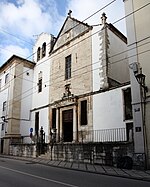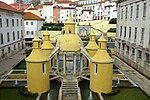Santa Cruz (Coimbra)
Former parishes of Coimbra

Santa Cruz is a former civil parish in the municipality of Coimbra, Portugal. In 2013, the parish merged into the new parish Coimbra (Sé Nova, Santa Cruz, Almedina e São Bartolomeu). In 2001, its population was 6866 inhabitants, in an area of 5.56 km² that parallels the north (right) margin of the Mondego River, extending to the village of Adémia in Trouxemil (its density is approximately 1235 inhabitants per km²).
Excerpt from the Wikipedia article Santa Cruz (Coimbra) (License: CC BY-SA 3.0, Authors, Images).Santa Cruz (Coimbra)
EN 111-1, Coimbra Pedrulha (Coimbra (Sé Nova, Santa Cruz, Almedina e São Bartolomeu))
Geographical coordinates (GPS) Address Nearby Places Show on map
Geographical coordinates (GPS)
| Latitude | Longitude |
|---|---|
| N 40.227777777778 ° | E -8.4461111111111 ° |
Address
EN 111-1
3025-307 Coimbra, Pedrulha (Coimbra (Sé Nova, Santa Cruz, Almedina e São Bartolomeu))
Portugal
Open on Google Maps








